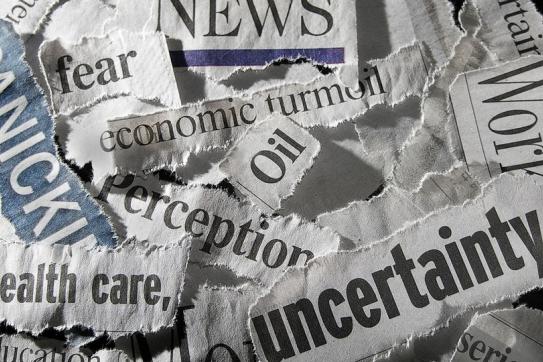On March 11, the Dow Jones industrial average plunged 1,485 points, ending the longest bull-market run in history, and sending the market into nosedive the likes of which has not been witnessed since the Great Recession. While it could take years to fully understand all of the factors that led to this recent crash, a consensus has emerged that fear of an economic downturn brought on by the coronavirus has played a large role.
In the wake of the collapse, new research shows that dire predictions for a COVID-19 pandemic – and its potential impact on the economy – may have been fed by the market decline itself thanks to the non-stop flow of news about the novel coronavirus. In times of volatility like the COVID-19 pandemic, financial markets can be highly influenced by anxiety reported in the media, even on days when fundamental conditions do not significantly deteriorate.
We are in the middle of a non-virtuous market cycle heightened by non-stop media reports. Sure, stock prices should naturally be lower now than they were a month ago when we knew less about the virus, but the extreme swings we’re seeing are tied to the ceaseless news stories covering the crisis, which in turn is causing a hyper-reaction in the market that we would not see otherwise. Market conditions are worse than they likely should be because of the media’s justifiable concern with the virus and its resulting impacts. The media produces news its customers want to read, but the extreme market volatility seems to be a consequence of this dynamic.
Using natural language processing (NLP) – a process that can analyze vast amounts of human-generated text in real-time – to analyze Reuters news articles mentioning “coronavirus” or “COVID-19,” linked the tone of these news articles to changes across key market indicators: the S&P 500, VIX, high-yield corporate bond indexes, and US Treasury yields.
This statistical model looks at how positive or negative framing of different aspects of the COVID-19 crisis mentioned in news stories tracks with market fluctuations.
There is a significant correlation between topical sentiment and market price, suggesting that the coronavirus outbreak created an environment where the market is particularly responsive to news, more so than at other times. There are important links between today’s market reactions and tomorrow’s news flow about COVID-19, and vice versa. Despite their hyper sensitivity to news flow, markets are nevertheless remarkably prescient about the future incidence of coronavirus cases.
These findings could represent a dramatic shift in the consensus regarding the relationship between financial markets and news coverage. The study suggests that markets and media coverage can create a vicious feedback loop, that in effect feeds its own extreme volatility. News attitudes can undoubtedly have hypersensitive reactions to bad days on Wall Street, but Wall Street similarly reacts hyper sensitively to an onslaught of negative news.
